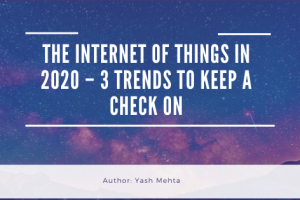The Internet of Things in 2020 – 3 trends to keep a check on

The device you are accessing this post from is a part of the 7 billion connected devices in the world.
Today, our homes are automated, apps are smarter and there’s a propelling market out there, burning the midnight oil to innovate further. While there’s no stopping to the mass acceptance, service providers want to look beyond and take up challenging g requirements, says Yash Mehta.
The Internet of Things is a powerful ideology that believes in addressing the most complex issues of the world. Subsequently, to be able to capture, stream and process large volumes of data has been the greatest achievement of the tech community with IoT providing the much-needed infrastructure while data science converting the efforts to valuable insights.
As we usher into 2020, IoT goes advanced and has some interesting use cases in development. Here’s a quick run-through.
The Internet of Medical Things
By 2020, 40% of all IoT devices will be deployed in the healthcare ecosystem.
Rising costs in making healthcare accessible while increasing expectations from the consumers have compelled the service providers to innovate further. Henceforth, emerging technologies, with IoT at the forefront will benefit from the supportive environment.
Healthcare monitors and portable devices, medical CRM systems & wearable devices contrive to create a network of connected infrastructure, recently termed as the Internet of Medical Things. Subsequently, mobile applications derive conclusions from the IoT channel and enable physicians & guardians to seek the analytical progress of the patient.
For example, digital Smart Pills approved by the FDA contain an ingestible sensor that records the timings of the medication taken. In the event of skipping, the physician or the guardian could be notified. Given such an intricate application, IoT in medicine is a promising innovation to bet upon.
However, IoT applications don’t restrict to ‘post-admission to hospital’ phase only. Some wearables and implants help a physician analyse the medical readings of an individual in routine. Take, for example, smart cars that communicate the driving patterns of an individual, the associated heart rates and other details. Similarly, wearable devices that enable an individual to record basic ECG, active & passive calories burnt, etc.
Growing at a compound annual growth rate of 26.2%, the market value of the IoT in the healthcare domain will touch $72,000 million (€64,937 million) by 2021.
Such a transition from reactive to preventive care has once again, positioned patients at the centre while ensuring reduced visits to the clinics and a healthier society altogether.
Elevated security for home IoT
Look beyond controlling microwave ovens & air conditioners from the mobile, home IoT solutions do a lot more today. From motorised window blinds, CCTV equipment, audio appliances, smart door locks, thermostats, and others, the internet has paved its way into the most personal space we could be in and if security is overlooked, this isn’t a great advancement.
Given the increasing number of channels that connect your home with the outside world through IoT, VPN and even guests requesting access to your home Wi-Fi, the entry points for hackers increase and so does the risk of data infiltration.

Yash Mehta
To put it straight, enterprise-grade security for home networks is the need of the hour as a plethora of critical private data is at risk. No matter how reputed the brand is (Alexa from Amazon or Home from Google), security risks haven’t been addressed as they should have.
While the service providers are locking horns with combating the vulnerabilities, waiting for them isn’t the way ahead. Home users must wake up to take initiatives and educate themselves about the best possible remedies. If basic security measures are taken by the users themselves, more than half of the risks are contained. To reduce the risk of IoT at home, start with the router.
Use the default IP 192.168.1.1 in the web browser and enter your default router password in the login section. Check for firewall settings, Kill Switch, VPN, antivirus applications and the list of all the devices connected to the network. Furthermore, create a separate guest network for outsiders so that their devices don’t access the IoT network in any way.
80% of network intrusions occur due to unchanged default passwords and other settings. You know where to start.
A step ahead towards smart cities
This is a dream actualising for many nations, especially those who have to deal with erring criminals in densely populated cities. Although CCTV deployment, surveillance kiosks, and other implementations are in widespread practice, their functionality will be enhanced, making them faultless and dependable.
Seol, Boston, and Singapore have already implemented advanced applications driven by big data and a channel to IoT to stream valuable insights. To be able to gather accurate and timely information through connected devices is of greater importance for the civic authorities as they are directly battling the pressure on amenities and reduced quality of livelihood. Henceforth, controlled traffics, lesser cars, lesser pollution, and safer socio-economic setup is the driving force behind the vision of automated cities.
However, this is just the tip of the iceberg! A smart city is a huge ideation and aims at automating every service. This includes containing criminal tendencies, fastening processes and a lot more.
Final thoughts
The IoT is huge and it is everywhere. The challenge, if any, isn’t expanding its reach but to use it appropriately and that’s what the current developments should focus on. There’s an oceanic collection of devices, appliances, networks, and users forming a network. Going forward, the vision should be to steer the potential of the connected and make our lives smarter yet simpler & safer.
The author of this blog is Yash Mehta an IoT and Big Data Science specialist. He is an award-winning writer appearing in multiple publications.
Comment on this article below or via Twitter @IoTGN
